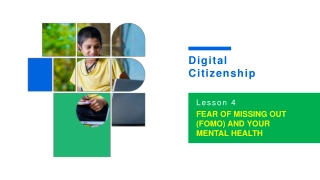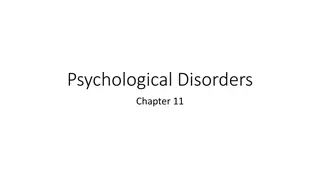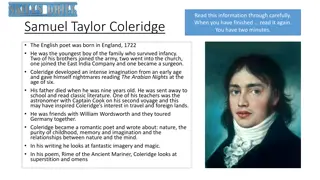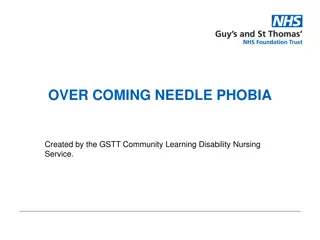
Fear, Learning, and Neural Pathways: An Exploration
Dive into the intriguing world of fear, learning, and neural pathways. Understand the innate and learned aspects of fear, explore how associative learning occurs, and uncover the mysteries of Pavlov's experiments with dogs. Discover the complex mechanisms behind fear conditioning and the role of neural pathways in shaping our responses to various stimuli.
Download Presentation

Please find below an Image/Link to download the presentation.
The content on the website is provided AS IS for your information and personal use only. It may not be sold, licensed, or shared on other websites without obtaining consent from the author. If you encounter any issues during the download, it is possible that the publisher has removed the file from their server.
You are allowed to download the files provided on this website for personal or commercial use, subject to the condition that they are used lawfully. All files are the property of their respective owners.
The content on the website is provided AS IS for your information and personal use only. It may not be sold, licensed, or shared on other websites without obtaining consent from the author.
E N D
Presentation Transcript
Starting Activity Sketch the electrical circuit (or pathway) that starts your car. The sketch should include switch (when you insert the key in ignition), to .. to .. Or you can sketch any other electrical pathway in a car or in your house, etc. that is of interest to you.
What is fear? We all have experienced feelings of fear and different types of fear. These fears can range from being scared when you see a hot stove nearby to the fear of heights ..both due to the harm it can cause you if the hot stove burns you, or if you fall from the heights! Now, is fear an emotion that we instinctively possess, or is it learned? Fear is of two types innate(e.g., fear of heights) and learned (e.g., not to touch a hot stove) Innate fear is not well understood in mammals and is a topic of research presently. We will focus only on learned fear. Note that learning of such fears occurs subconsciously, i.e., the subject is not aware that they are learning the fear. For instance, when a kid learns that 2x3 =6, they are aware they are learning it. Not so in the case of fear! Consider the case of touching a hot stove. When we do not know a hot stove would cause pain, we touch it without fear the first time. However, we will experience pain during the first touch. This sensation is caused by temperature and pain sensors in our fingers via a neural pathway that connects it to the brain. After touching a hot stove for the first time and experiencing pain, we learn to associate the hot stove with pain. That is, we learn to fear touching hot stoves. What changes in the neural pathways in our nervous system and/or brain are responsible for learning this fear? Such learning can occur with pizza too, i.e., when you first eat pizza, you love it, and the next time you see pizza, your mouth waters! Neuroscientists have been trying to investigate the neural pathways that implement this associative learning, which we will first explain using Pavlov s famous experiment with dogs!
What is a reward? .Pavlovs famous conditioning experiment with dogs! Pavlov devised an ingenious method in 1897 to find out how we may learn to associate neural stimuli (e.g., such as bell ringing; also termed conditioned stimuli) to unconditioned stimuli such as food. To explore the neural pathways that might be implementing learning to associate conditioned stimuli (such as sound, smell, light .) to unconditioned stimuli such as food or fear, scientists have been using the Pavlovian paradigm. So, we first consider the Pavlovian experiment and learn about all the terms involved note that he worked this out in 1897! VIDEO - Pavlov s famous conditioning experiment for reward learning. https://en.wikipedia.org/wiki/Classical_conditioning https://www.google.com/url?sa=i&url=https%3A%2F%2Fwww.medschoolcoach.com%2Fclassical-conditioning-mcat- psychology%2F&psig=AOvVaw3Lk72Dom6sML44koX94ZxJ&ust=1730061367940000&source=images&cd=vfe&opi =89978449&ved=0CBQQjRxqFwoTCMiFwYzzrIkDFQAAAAAdAAAAABAE
Pavlovian auditory fear (similar for reward) conditioning An experiment to train rats to fear a particular sound First, you have to know that when a rat is fearful, it will either freeze or run. If a rat is in a cage, it cannot run, so fear is exhibited by freezing. The level of fear is scored by noting how long a rat freezes automated programs are available to score this using the experiment video. Different rodents exhibit different levels of fear, as is true with humans. The rat fear conditioning experiment is as follows: (1) Rat will first hear a tone (sound) by itself and gets habituated to it and ignores it after some time. (2) In the next stage, the rat then hears the same tone but this time it will be accompanied by a shock, causing it to feel pain. This is called a conditioning trial . The number of conditioning trials typically varies from 5 to 10, depending on the intensity of the shock. (3) After the conditioning trials, the rat will again hear the tone by itself, and its fear will be scored automatically using video frames. Can you guess the rodent response after conditioning (3) as compared to before conditioning (1)? Watch the following one-minute video for the answer: https://www.youtube.com/watch?v=mi2gqhHw1N0
Tone-shock fear conditioning in rodents After watching the fear conditioning video, can you guess why the rats behaved differently after conditioning? What neural pathways may have changed, and what specific changes occurred? Jot down your thoughts.
Neurons connect to each other via synapses The tone comes in as a series of spikes or electrical impulses from the neuron in the sensory neuron in the ear. The axon of the tone neuron connects to the amygdala neuron via a synapse shown in the figure two semi-cylindrical pieces with a gap in between. The synapse has two parts; the left side is called the pre-synapse, and it is connected to the tone neuron, and the right part is called the post-synapse, which is connected to the amygdala neuron. The electrical impulse is transmitted from the pre- to the post- synapse via neurotransmitters. This is the role of the synapse, i.e., to transmit electrical impulses from one neuron to another. Let s see how this information can be used to study the two neural pathways. One is between tone and the amygdala, and the other is between shock and the amygdala. Optional if you are interested, you can learn more about synapses using web resources. Axon from tone neuron Synapse Amygdala neuron Generated in our Lab- Neural Engineering Laboratory, University of Missouri-Columbia 7
What is the neural pathway for the tone reward and fear cases? The pathway for food stimulus and for shock stimulus is similar. Can you sketch them for the fear conditioning case? 8 Generated in our Lab- Neural Engineering Laboratory, University of Missouri-Columbia
What is fear conditioning? RECAP: In our experiment, the rats appeared to initially not respond to the tone and continue their behavior without any type of response. During the fear conditioning phase, the tone co- terminated with a shock, i.e., tone and shock were paired. After such pairing, the rats started to freeze after hearing only the tone. Why did the rats freeze? The rats froze because they had learned to associate the tone with shock during the conditioning trials. That changed something in the neural pathways related to fear. This is why subsequent presentations of only the tone, i.e., without shock, caused the rats to get into the fear state and freeze.
How is the brain involved in learning fear? The brain is a complex organ responsible for thinking, emotion, memory, vision, and several processes that allow the body to function and is the computer of the body. The part of the brain called the amygdala is involved in processing and learning fear. The schematic shows how the amygdala was involved in the tone and shock experiment. The amygdala interacts with several regions and is thought to implement behavioral responses via projections from its output site (Ce nucleus). These are the neural pathways and regions that implement fear! We will study more about neural pathways in later activities. OPTIONAL: The output from Ce goes to periaqueductal gyrus (PAG) to implement freezing, to the lateral hypothalamus to increase blood pressure and the paraventricular nucleus to release hormones. This lecture will only focus on the initial pathway. https://www.nature.com/articles/nrn728
Both tone and shock pathways together Generated in our Lab- Neural Engineering Laboratory, University of Missouri-Columbia
Humans have two almond-sized amygdala on either side of their head, shown in red in the figure on the left. https://upload.wikimedia.org/wikipedia/commons/8/8b/Amyg.png
What is FEAR, and why do YOU feel Scared? (4.5 min) Beautiful Science
Activity 2.1 Sketching neural pathway In the rodent fear conditioning video, the tone enters the brain via the ear and travels to the amygdala as electric impulses (spikes) via the axon (like a wire). The shock enters the brain via the foot of the rodent and also goes to the same amygdala neuron via its own axon. All sensory signals typically go through a region of the brain called the thalamus, which is essentially a relay station. TO DO: Sketch a human face in the front view and show the almond-shaped amygdala on the left and right sides (in your brain too). Now sketch the tone neural pathway for the rodent, with one neuron in the ear, one neuron in the thalamus (relay station), and one neuron in the amygdala. In the same rodent figure, add the shock neural pathway, with one neuron in the foot, and one (separate) in the thalamus, going to the same neuron in the amygdala.
Activity 2.2 - Designing an electrical circuit YOUR CHALLENGE: Go into the virtual lab provided at https://phet.colorado.edu/en/simulations/circuit-construction-kit-dc and click on the play button to get started. Then build two separate electrical circuits : one for the tone pathway and another for the shock pathway. How do they differ? Hint - you will need a battery, a wire, a resistor, and a light bulb After they are done, show them the breadboard circuit with one circuit battery, wire, resistor and light bulb or LED. Explain how that works, to consolidate their understanding of a circuit or pathway. Solution for the teacher is provided at the end of this set of slides.
Activity 2.3 - Pavlovian reward conditioning In this activity, you will use the Colab notebook what-is-fear.ipynb to comprehend how the amygdala fires in response to reward in the case of a bell ring when it has previous been paired with a reward of food. You will thus learn about how reward is learned at the neuronal and neural pathway levels. TO DO: Adjust the given values to get the amygdala neuron (a different one from the fear neuron) to fire at the baseline value of < 0.5 Hz (once in 2 seconds). Adjust the given values to get the amygdala to signal food, i.e., fire at a value of approximately 5 Hz (five times per second). Note that this represents a different neuron from the fear one.
Activity 2.4 Pavlovian fear conditioning In this activity, you will use the Colab notebook what-is-fear.ipynb to comprehend how the amygdala fires in response to sound during the baseline state, e.g., when you hear music that you like. You will then find out how the amygdala signals fear for the same sound when it has previously been paired with a scary outcome, i.e., shock. You will thus learn how fear is learned at the neuronal and neural pathway levels. TO DO: Adjust the given values to get the amygdala neuron to fire at the baseline value of < 0.5 Hz (once in 2 seconds). Adjust the given values to get the amygdala to signal fear, i.e., fire at a value of > 7 Hz (seven times per second).
Conclusion We learned about the neural pathways that cause us to fear, and that fear can be both innate and learned. We learned about Pavlovian reward conditioning with the dog. We also learned about Pavlovian fear conditioning, and how it was applied in an experiment involving rats using a tone and shock. We explored the neural pathways in the mammalian brain that are responsible for learning reward/fear and how the amygdala responds to fear. Specifically, we focused on the pathway that goes from sensory neurons to the thalamus and then to the amygdala. Later tutorials will build on this and provide details.
Why should this interest me? The fear circuit is also involved in mental health disorders such as ANXIETY, PHOBIA, etc. . Not understood presently and thus an attractive area for research in your career if interested. What is fear? - A response to an immediate threat; activates the flight-or-fight response; results in increased heart rate and blood flow What is anxiety? - Apprehension about a future threat; causes muscle tension, vigilance, caution, or avoidant behavior What is phobia? - Persistent, unrealistic, and intense fear of a specific stimulus; causes avoidance behavior 19
References and additional reading Mobbs D, et al., On the nature of fear, (Oct 10, 2019) Scientific American Joseph LeDoux, Redefining fear, APS William James Fellow Lecture (2015) Insel T, Faulty Circuits, Scientific American (2010)
Solution to Activity 2: Top tone pathway, Bottom shock pathway Note: Bulb is brighter in the shock pathway, i.e., mimics amygdala firing at a higher rate of 7 Hz https://phet.colorado.edu/en/simulations/circuit-construction-kit-dc





















